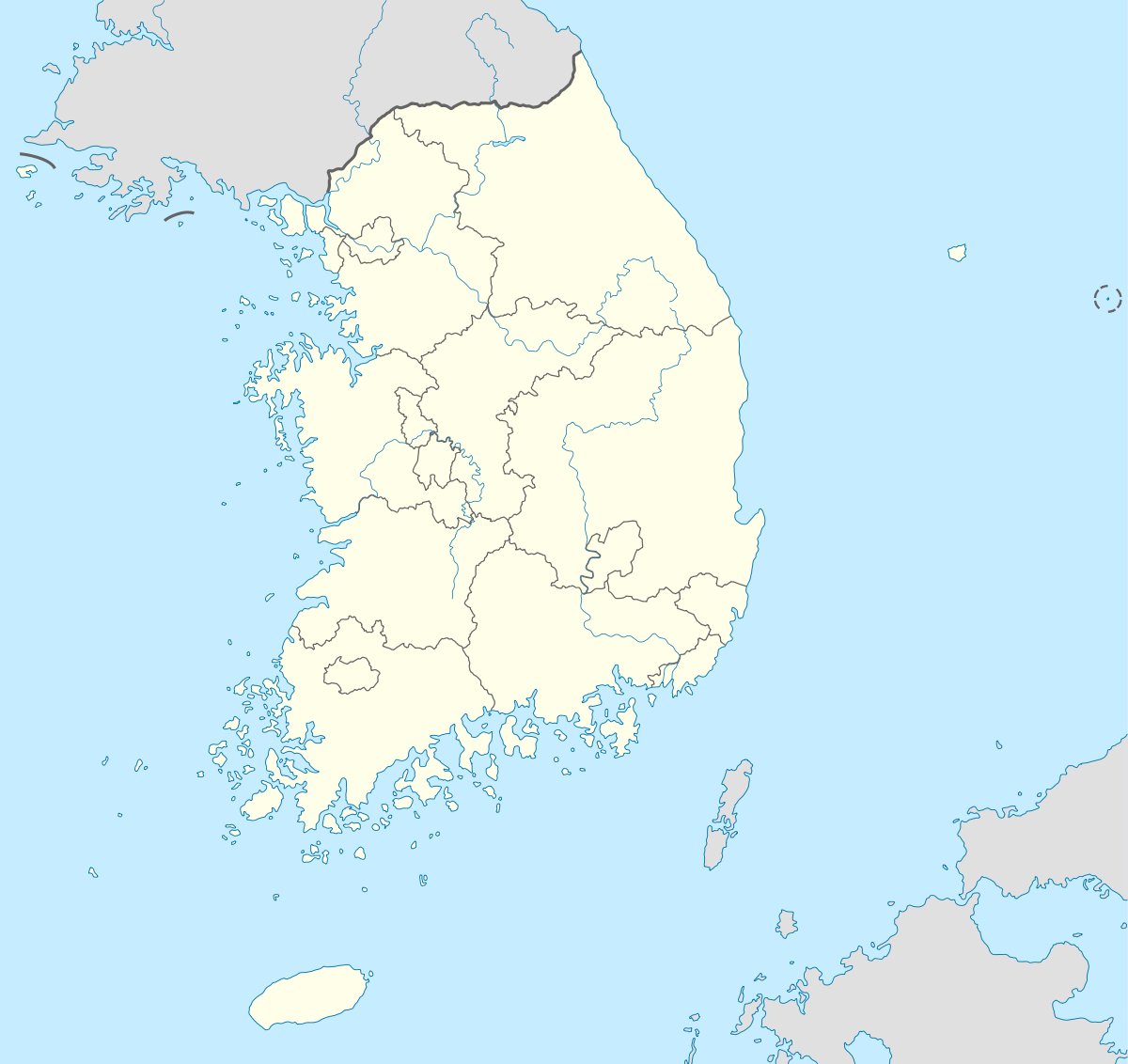Suwon Air Base
| Suwon Air Base Suwon Gonggun Kige Suwon Konggun Kige | |||||||||||||||
|---|---|---|---|---|---|---|---|---|---|---|---|---|---|---|---|
 SWU | |||||||||||||||
| Summary | |||||||||||||||
| Airport type | Military/Public | ||||||||||||||
| Operator | Republic of Korea Air Force | ||||||||||||||
| Location | Suwon | ||||||||||||||
| Elevation AMSL | 88 ft / 26.8 m | ||||||||||||||
| Coordinates | 37°14′08″N 127°00′34″E / 37.23556°N 127.00944°E | ||||||||||||||
| Runways | |||||||||||||||
| |||||||||||||||
Suwon Air Base (IATA: SWU, ICAO: RKSW) is a Republic of Korea Air Force (ROKAF) base near Suwon city.
Units
The base is home to the ROKAF's 10th Fighter Wing (제10전투비행단), comprising:
- 101st Fighter Squadron flying KF-5E/KF-5F/F-5F
- 201st Fighter Squadron flying KF-5E/KF-5F/F-5F
The US ARMY 6th Battalion, 52nd Air Defense Artillery Regiment operating Patriot missiles is stationed at the base.[1]
History
Korean War
The base was originally established during the Korean War as Suwon (K-13) Air Base and hosted United States Air Force units.[2]
The base was evacuated on the night of 30 June 1950 in the face of the Korean People's Army (KPA) attack, but the base was not occupied by the KPA until 2 July 1950.[3]
The base was recaptured on 24 September 1950 following the Inchon landings.[4] The 811th Engineer Aviation Battalion arrived at the base on 1 October to repair the airfield and laid down PSP over the runway.[5]
The base was evacuated in the face of the Chinese Third Phase Campaign on 5 January 1951 and the base's buildings were destroyed.[6] The base was recaptured on 28 January as part of Operation Thunderbolt[7] and by 6 March, despite its poor condition, the base was used for the staging of F-86 patrols along the Yalu River and Mig Alley.[8]
USAF units based at Suwon included:
- 4th Fighter Wing from 30 March-23 August 1951
- 8th Fighter Wing from 23 August 1951-20 October 1954
- 51st Fighter Wing from 1 October 1951-26 July 1954
- 12th Fighter Squadron operating P-51s in 1950
- 16th Fighter Squadron operating F-86Ds from 20 May 1951-July 1954
- 25th Fighter Squadron operating F-86Ds from 1951-4
- 35th Fighter Squadron operating P-51s in 1950 and operating F-80s from 1951-52 and operating F-86F Sabrejets from 1953-54
- 36th Fighter Squadron operating P-51s in 1950 and operating F-80s from 1951-4
- 39th Fighter Squadron operating F-86Ds from 1952-4
- 67th Fighter Squadron operating P-51s in December 1950
- 68th Fighter Squadron operating F-94s from March-19 April 1951, 23–27 June 1951 and 24 August 1951 – 23 March 1952
- 80th Fighter Squadron operating F-80s and later F-86s from 24 August 1951-21 October 1954
- 319th Fighter Interceptor Squadron operating F-94Bs from 10 March 1952-17 August 1954
- 334th Fighter Squadron operating F-86s from 10 March-1 May 1951
- 335th Fighter Squadron operating F-86s from 1 May-1 August 1951
- 336th Fighter Squadron operating F-86s from 6 April-27 June 1951
On 17 June 1951, at 01:10 hours, Suwon was bombed by two Korean People's Air Force Polikarpov Po-2s. Each biplane dropped a pair of fragmentation bombs. Two bombs burst on the flight line of the 335th Fighter Squadron. One F-86A #49-1334 was struck on the wing and began burning, the fire took hold, gutting the aircraft. Eight other Sabres were also damaged in the attack.[9]
On 22 December 1952 a Hellenic Air Force C-47D #49-2612 was taxiing at Suwon Air Base when it was hit by USAF F-80 #49-0722 that was taking off, killing all 13 on board the C-47.[10]
Postwar
USAF units based at Suwon included:
- 25th Fighter Squadron operating A-10s from 1981-9
- 82nd Fighter Squadron operating F-102s from 30 January-20 February 1968 as part of Operation Combat Fox and rotation from 1968–71
- 336th Fighter Squadron operating F-4s from 25 March – 17 April 1977
On 10 October 1984 Northrop F-20 Tigershark 82-0062, c/n GG1001, N4416T, during a world sales tour, crashed at Suwon, killing Northrop chief test pilot Darrell Cornell. During the last manoeuvre of the final demonstration flight, the aircraft stalled at the top of an erratic vertical climb and dove into the ground from 1,800 feet.[11][12]
On 23 May 1996, Korean People's Air Force Captain Lee Chul-Su defected in Shenyang J-6 #529, landing at Suwon.[13]
On 5 May 2006 Captain Kim Do-hyun of the ROKAF's Black Eagles display team was killed when he lost control of his A-37B Dragonfly during an air show.[14]
References
- ↑ "New missile battalion to stay at Suwon permanently". Stars and Stripes. 22 May 2009. Retrieved 20 June 2013.
- ↑ "K-Bases in Korea". National Museum of the US Air Force. Retrieved 21 May 2013.
- ↑ Futrell, Frank (1983). The United States Air Force in Korea, 1950-1953. Air Force History & Museums Program. p. 34. ISBN 9780912799711.
- ↑ Futrell, p.161
- ↑ Futrell, p.179
- ↑ Futrell, p.279
- ↑ Futrell, p.293
- ↑ Futrell, p.295
- ↑ "ASN accident #59422". Aviation Safety Network.
- ↑ "ASN accident 49-2612". Aviation Safety Network.
- ↑ Peterson, Wayne, "Tigershark!: The Freedom Fighter's Last Hurrah", Wings, Woodland Hills, California, June 2006, Volume 36, Number 6, page 52.
- ↑ Martin, Guy, "Northrop F-20 Tigershark: An undeserving failure", International Air Power Review, Volume 27, AIRtime Publishing, Inc., Westport, Connecticut, 2010, pages 109, 111.
- ↑ "NK pilot defector promoted to colonel". Korea Times. 16 November 2010. Retrieved 20 June 2013.
- ↑ Mitchell, Terence (2006-06-10). "Pilot Deaths Put F-15 Deal in Doubt – Korea stunned by deaths of 3 pilots in less than a month". Ohmynews. Retrieved July 6, 2008.
External links
| Wikimedia Commons has media related to Suwon Air Base. |
| ||||||||||||||||||||||